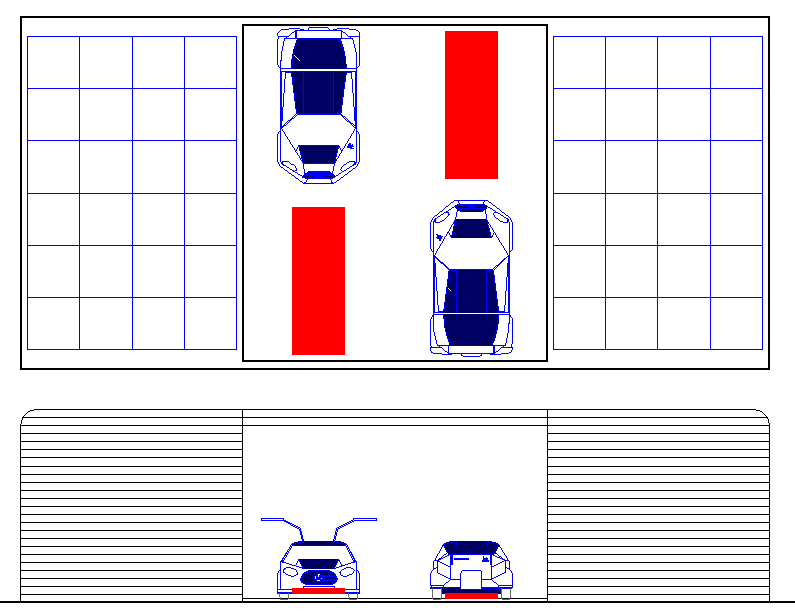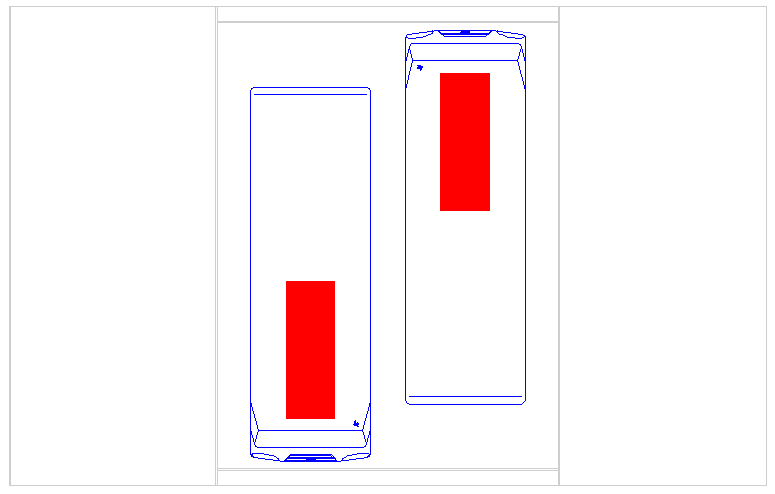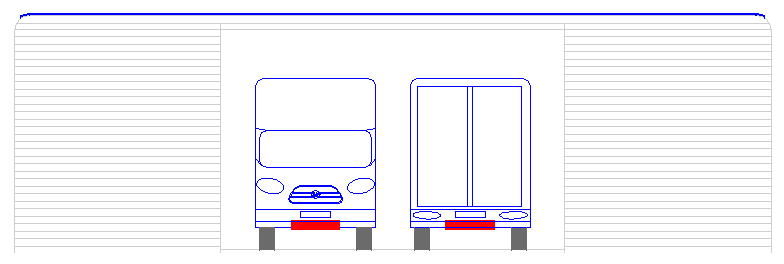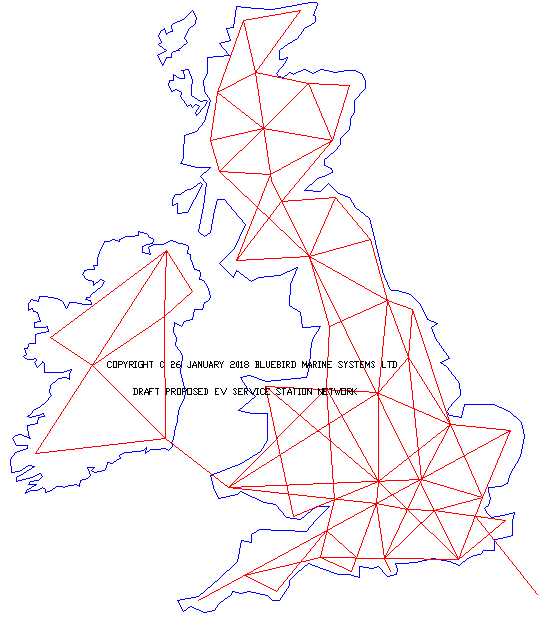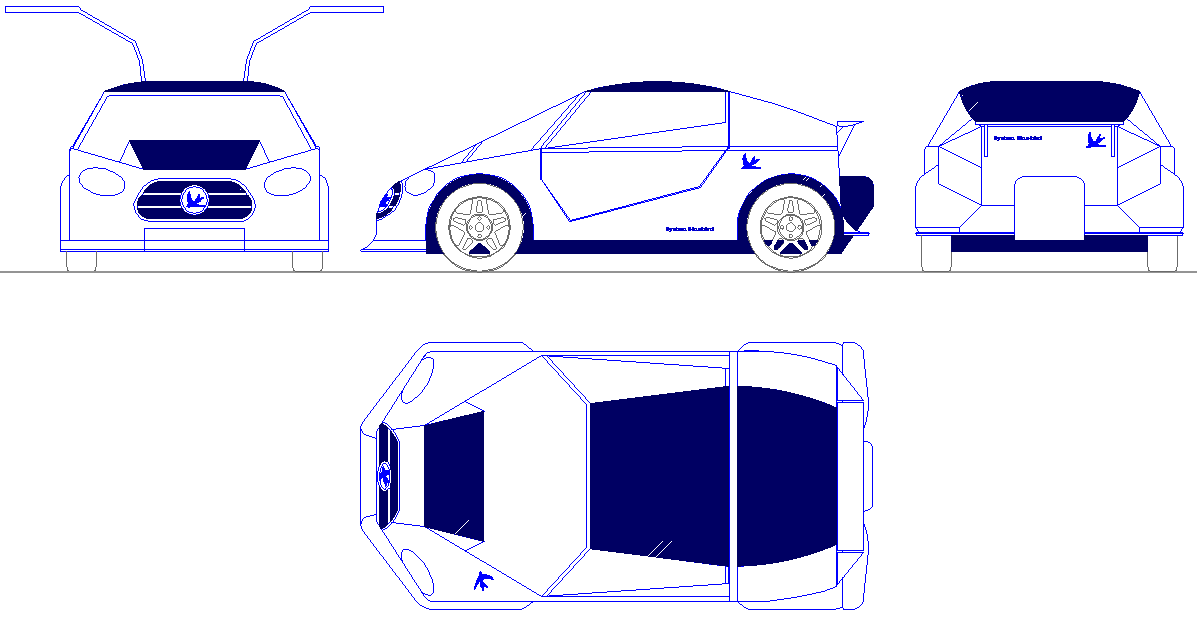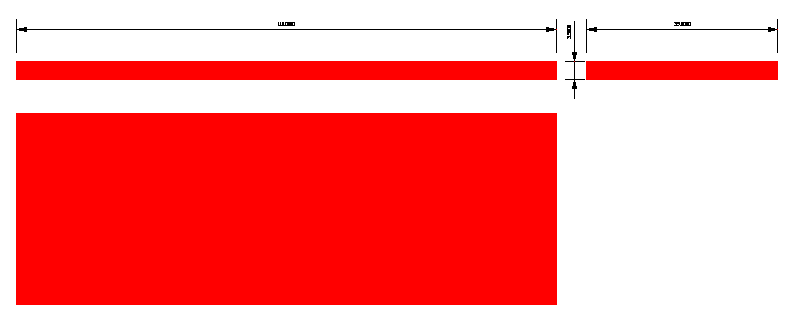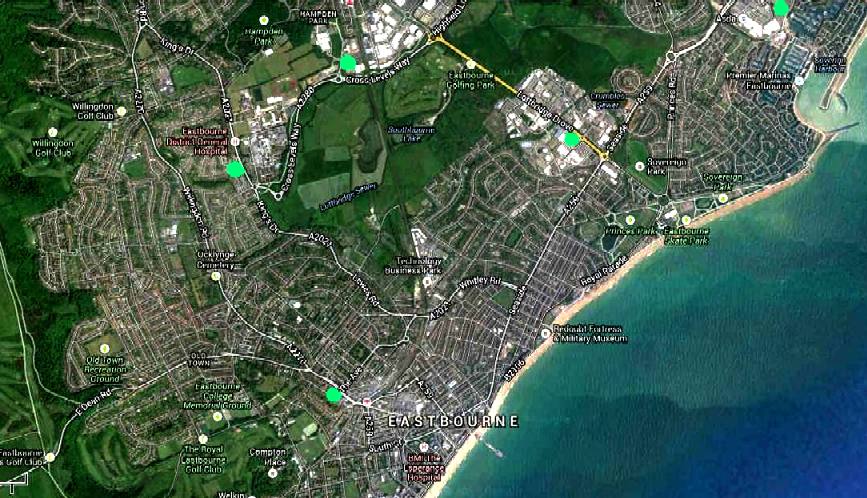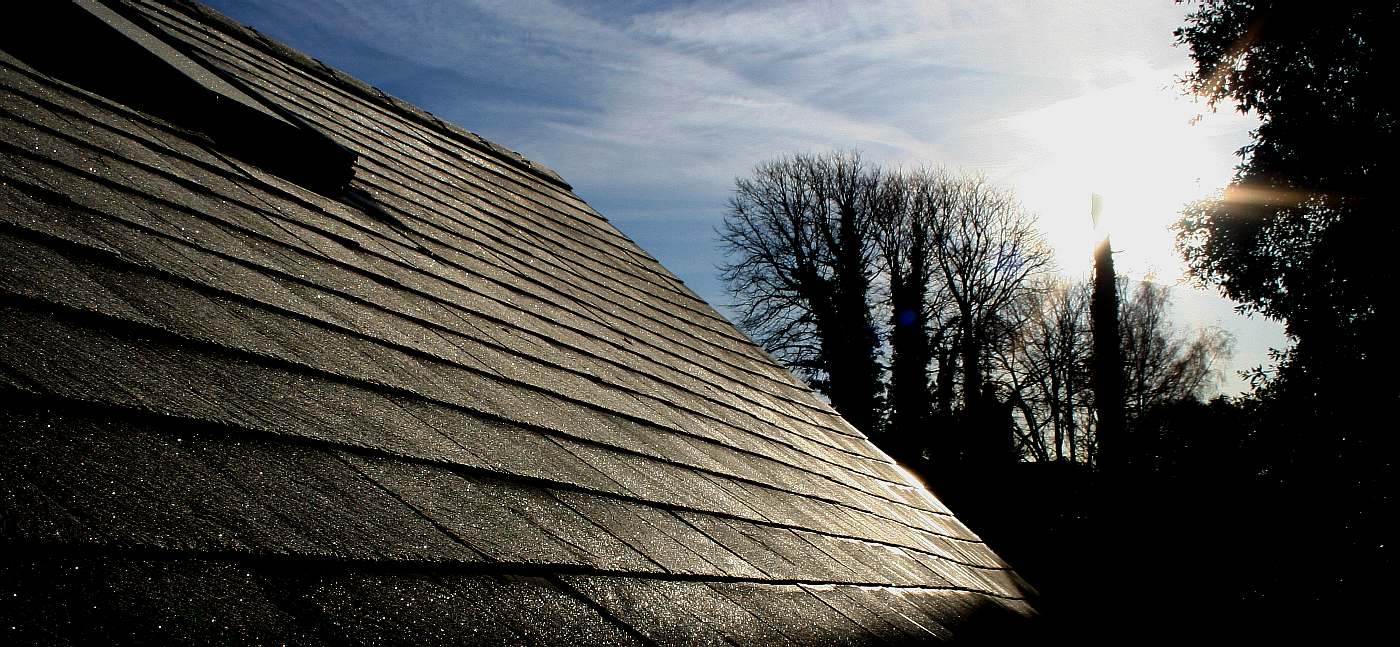|
EUROSTATION™
NATIONAL GRID - SMART NETWORKED CITIES
|
|||||||||||||||||||||||||||||||||||||||||||||||||||||||||||||||||||||||||||||||||||||||||||||||||||||||||||||||||||||||
|
PROPOSED EURO-STATION PROTOTYPE: Shown here is a Bluebird™ 2.4MW - 3.44MW (as 60kW/hr or 86kW/hr packs) solar assisted service station containing 40 cartridges on a continuous charge cycle. Five of these stations (12 - 17.2MW) can recharge (refuel) 10 cars a minute. Next time you visit your BP or Tesco fuel pump, count the number of cars leaving the station in a minute. You will find that an electric forecourt holds the potential to be quicker. During rush hour, 300 cars might be serviced in one hour. During an eight hour day 2,400 cars might be serviced - with the equivalent battery charge cycle of one hour - so less harmful to batteries than curbside fast charging and we start every morning with 200 slow charged cartridges from off-peak supplies. The same forecourt might be used to service fuel-cell cars powered by liquid hydrogen, or hydride pellets. One size fits all. NOTE: This is a flat-pack design to keep costs down. Flat pack buildings can be put up and dismantled for relocation in a matter of days. We are even considering a portable solution as a means to test out locations and give demonstrations.
EV INFRASTRUCTURE PROJECT - What lays ahead for drivers in the UK once petrol cars are no longer allowed to be sold after 2040. That happy situation for environmentalists is more of a challenge to managers of the National Grid, not too mention local authorities who need to think hard and plan ahead for our low carbon future - and that may not be electric vehicles - but they are the front runners at the moment. The truck shown here is 3.55 wide x 3.5 high x 7.7M long (8 x 11.5 x 25 feet). This station could accommodate trucks 4.46M (14.77 feet) high as shown, or with a raised roof, almost any truck currently on the market - though longer thinner trucks are more fuel efficient.
THE DAMBUSTER As with the bouncing bomb, it takes more than just the initial idea to make a system viable. Barnes Wallis came up with the idea for releasing a spinning bomb from a plane of his design. That was based on a discovery by Horatio Nelson that cannon balls travel further if bounced off the ocean. But it was Guy Gibson who came up with the method of keeping the Lancasters just feet above the water, and another MOD spark who provided the hand held sights, as bomb release aimer. Only with all three innovations was it possible to release a bomb as the right distance and height from the target dams. Likewise, with the EuroStation and UniCartridge, there are hidden factors needed to make the system workable. Factors that we cannot reveal prior to patent, but that we can share under the protection of a Non Disclosure Agreement, that we will provide at no cost to your company.
STOP PRESS: WITH LITTLE OR NO POLITICAL WILL AND OTHER MATTERS PRESSING, WE'VE PLACED THIS PROJECT ON HOLD IN FAVOUR OF SEAVAX.
EDF PULSE AWARDS - NEWS FEED 2016 CONFIRMS OUR DECISION TO FREEZE PROJECT WAS THE RIGHT MOVE.
WHERE TO START - It's a chicken and egg situation with EVs needing service stations and service stations needing EVs they can service. Fast charge is not the answer for a sustainable society. Fast charge systems damage batteries and put a strain on generating networks, creating peak times when more capacity will be required. Motorists don't like the idea that they have to wait so long for energy, the wait instills "range anxiety" in EV users where they are constantly looking at their charge meter and planning for the next stop - for another long wait while their vehicle fast charges.
THE CURE - Is a vehicle that exchanges energy cartridges itself using built in loaders. The car then becomes the egg and the chicken:
* It is the egg because it creates a need for service stations while serving itself meantime.
* It is also the chicken, because the cartridges that need to be charged creates a need for service stations.
Read about the concept car that we hope will trigger the imagination of politicians by clicking on the chicken above - or see our PowerPoint.
WHAT
IS IS SMART INFRASTRUCTURE
* Predictive – models of the grids can be created and used to plan and operate systems;
* Integrated – no longer a hierarchy from generator through distribution network to consumer. Supply, consumption and control can occur at many locations on the grid;
This becomes important when the majority of vehicles are electrically powered, as is likely in the next 15 - 35 years as world population continues to grow with modernization of developing nations both major contributors to climate change.
OCTOBER 2014 STANDSTILL - Realizing that funding for the concept was a pipe dream, we ceased spending. At present we have no budget for technology that challenges IC engines and fast charge - essential though that may be for a truly circular economy - it is innovation that is too far ahead of its time to be considered a good commercial risk. We are an R&D company that maybe should have an academic constitution. We are not yet a trading concern or manufacturer.
JANUARY 2016 - One day we hope the political will might be with us - when (if the funding rules change dramatically) you can watch this car turn into a motoring gem, as it rises like a Phoenix from the ashes. We are a non-trading company in waiting. If we'd been a university we would have been eligible for 100% funding and this car would have been exhibited and written about such that all world leaders can see the potential. Disruptive technology like this should be state funded, not for SMEs to risk all - as we say - swimming against current thinking.
OFFSHORE WIND & SOLAR ENERGY FARMS
Is it not an incredible fact that many countries are encouraging the installation of wind and solar farms, with no thought (forward plan) whatsoever for the means to utilize all of that clean energy for transport. It is as though political world leaders are just praying for a miracle. Having been burned by the likes of Better Place, you'd think they would want to get back on the horse with more than just a prayer in hope of a solution. All indications are to the contrary. To date BMS have received no enquiries from governments anywhere as to the solution posed on this and other pages and websites. Political apathy is the main reason that 2050, targets will not be met, and the less said about 2030 targets the better.
HOW CAN YOU HOPE TO IMPLEMENT AN EV TRANSPORT INFRASTRUCTURE?
The 'how' is what has been eluding motor vehicle makers (MVM) and governments around the world for decades. The answer is gradually, with a system that instills confidence, consisting of:-
A. The 1st essential building block is an energy storage medium that will fit 95% of existing or close to production new vehicles. With EVs this has to be a battery or fuel cell store in the form of a cartridge.
B. The 2nd essential building block, is vehicles that can replenish the onboard energy storage medium as in A. by itself, rather than relying on service stations that do not yet exist.
C. The 3rd and final building block, is a cheap service station that is compatible with the 1st essential building block A. and so B. - and that completes the puzzle.
It's as simple as A B C.
PSYCHOLOGY
Once MVMs realize that such a storage medium will fit their future vehicles, and that this is a selling feature that gives them a market advantage, they will want to avail themselves of the market advantage. Otherwise its Kodak time, as newcomers embrace change, leaving shy boys out in the cold.
The market advantage is that EV customers want assurances as to technology change. In other words; future proofing - and that is where A. above is necessary to boost confidence in a market that is still evolving. Evolving technology is where the buying public get burned, See Betamax Vs VHS and all of that was wasted money when DVDs came along and now Blu-ray. We think you can see the problem, if that kind of swapping between formats became an issue with electric vehicles, who would want to invest in the wrong format infrastructure. The answer to that is nobody. Stalemate.
BUSINESS METHODOLOGY
Okay, so let us say that we've got a few cars into production using A. What next?
Then we negotiate with energy providers, such as supermarkets and other petrol stations, to allow UniCartridge compatible car owners to store a number of A. units to cope with known customers. Note, at this stage that you do not need C., because the future proofed EVs can service themselves. And that is the missing link at the moment. Every other system currently suggested requires C. at the outset. And that is a business model doomed from the outset.
You have to build up demand gradually, to include park and charge. Drivers will want EVs in cities if there is a congestion charge based on emissions and EV exemption. That said, it is unclear if pure EVs are exempt in London, and we are actively seeking clarification of their wishy-washy policy. Only cities that are EV friendly might qualify as smart cities. At the moment it looks as though our own capital is a dumb city.
California is a location that offers up to $5,000 under their Clean Vehicle Rebate Project (CVRP) for the purchase or lease of new, eligible zero-emission and plug-in hybrid light-duty vehicles. If there was a similar incentive for supply of energy cartridges to EV customers - we might be onto a winning formula for 2030 targets.
It follows that cities and city cars should be the target vehicles that MVMs and offshore generators should focus on, save that park and charge creates more load issues. More on this later.
FEASIBILITY STUDY
While a global study may have more meaning, can you imagine the cost? Thus, as a first stage and to keep things containable, a feasibility study will focus on one geographical location, noting the number of vehicles and the frequency of service station visits, multiplied by the petrol/diesel sales and vehicle types. This will need to be cross referenced with the population.
From this basic information, the average mileage and mix of use can be estimated per capita with some degree of accuracy, hence the energy needs for the equivalent electric vehicle calculated. This gives us the target to aim for, starting with city car demand.
We need to emphasize the advantages of load leveling and instant recharging, over park and charge. This should be demonstrated with business models of both technologies for comparison purposes. otherwise, politicians will not know the 'why' such technology is essential.
PROTOTYPE EUROSTATION
Once a feasibility study is completed, the number of stations to supply an area can be calculated. This study may also reflect on the proposed EuroStation™, in terms of the basic design, as in, is/was that layout suitable. It is after all, a 'toe in the water' proposal based on a logical arrangement to keep the housing (building) small, so cost effective.
Another factor is to confirm the dimensions of the largest and smallest cartridge, such that the mass of the movement of the EuroStation (mechanically) is known - to be able work out and specify bearing sizes, structural steel sections and the like. For a flat-pack this is vital. We need to keep weight down, which also reduces material and transport costs.
By contrast, petrol stations contain underground holding tanks, surface pumps and a kiosk to collect money from a transaction that is variable, with most customers electing to pay in person at a desk, rather than use automatic credit/debit card transactions. A factor that slows down vehicle refueling considerably. But once again, this is change that customers are likely to resist.
UNIVERSAL ENERGY CARTRIDGES - Two basic concept designs for a Universal energy cartridge, both with 8 cubic feet of storage capacity. It is not so much the shape of the cartridge, it is that the ends are compatible with the car and the eventual service station. The pick-up and contact point details are not shown here due to patent laws prohibiting advance publication. Any shape cartridge may be suitable for a EuroStation™ service forecourt, provided that the basic "Universal" dimensions are adhered to. We will release these details one the applicable patent is in the processing pipeline. For any production car, we'd like to change the shape to a low profile design that is wider - still using the Universal connections of course. We have named this service station, EuroStation, when it could be a UniStation. Realistically, the most likely countries to consider adopting such technology are Denmark, Norway and Sweden, followed by Germany. Hence: EuroStation. This selection is based on current policies. Though, Arabian countries may be looking to advantage themselves of desert solar farms - in the move away from oil as the main income provider.
UNIVERSAL CARTRIDGE = UNICARTRIDGE
To be able to settle a standard that will cater for 95% of existing road vehicle designs, most vehicles currently being sold will need to be measured, so that the length of cartridge may be defined, as will fit between the axles or extend under or through axles, and remain within the bodywork unobtrusively. This is a vital stage that determines the physical size of a EuroStation.
We are not advocating a standard physical size or volume, just seeking to establish the hard points that new (or converted) vehicle designs should conform to. Fortunately, existing designs appear to require little modification to be able to adopt a EuroCartridge™ in forward models.
A similar study was probably conducted by Better Place (BP), and then again by Tesla, in formulating a cartridge size for EV models to be able to use their subterranean battery cartridge exchange system. Unlike the more complicated designs of BP, Tesla and those used at Kobe in Japan for buses, the EuroStation is a surface mount system, and that considerably simplifies installation so driving costs down - an entirely original concept.
TOWNSHIP SIMULATION
A prototype station may then be built to demonstrate the technology and collect data on performance. This will depend on having a number of electric vehicles in an area, where the drivers are prepared to be willing guinea-pigs.
A number of energy cartridges will be fed into the system, such that users may rely on instant exchanges. Costings at various stages will give an indication of mass implementation, starting with a town, then several towns, cities and eventually a whole country.
Of course this Utopic state will require assessment of each town looking to get linked in and become smarter.
THE DEVONSHIRE PROJECT: In this map of Eastbourne, 5 EuroStation™, EV service stations [shown in green] could (subject to feasibility study) service the whole town. Couple those five stations with solar car parks, and even more energy savings could be made - heading for truly green low cost transport. But it's not all economics, think about better local health from cleaner air. What might that mean for our NHS bill in years to come? One identified problem with being "smart" in the UK, is that town planners only work retrospectively and do not provide funds for eco housing or eco transport, but rather expect developers to stump up the cash, so that they can then pull private investor applications to pieces and cost more money to would be eco entrepreneurs.
EUROSTATION ESTIMATES
If BMS carries out this work, it will be considerably less costly as a development expense, over other engineering consultancies. BMS employs innovative hands on engineers.
The cost of a prototype station could be as little as £200,000 + the cost of land and ground works. To this must be added another £100,000 for ten energy cartridges and the same again to convert ten test cars, to carry Bluebird UniCartridges™ universal energy cartridges.
Realistically then we are looking to raise interest to raise funding in the order of:
The value of such a scheme is that administrations and automotive manufacturers around the world will be able to see a low cost practical unit, as the building block for reliable energy supplies and future smart cities. Local authorities that are serious about cleaning up their towns and cities should give us a call if they like the sound of this.
THE CHICKEN and EGG SITUATION
Without a pilot scheme, this will never come to fruition. It is a moderate risk for investors, but could be giant leap for mankind. Mr Armstrong would surely approve. Though, this is not rocket science. His actual words were: "That's one small step for man, one giant leap for mankind."
ITS NOT ROCKET SCIENCE - Our system is not the cure for cancer, but every little helps. The real stumbling block to change, is weak policy making and the low price of coal, that does not reflect the harm it is causing to the environment, that keeps profits level for generating conglomerates who are losing ground to offshore wind and solar farms. All the while oil is cheap, people will buy smelly IC engined cars and auto makers will keep making them - because it all boils down to the $dollar. Politicians know this but sit on their hands. This is why the planet is slowly frying from 'Boiling Frog Syndrome." Ribbit!
ENERGY GENERATING-DISTRI BUTION UTILITIES
SMART(ER) CITIES
A smart city
uses digital technologies to enhance performance and
well-being, to reduce costs and resource consumption, and also to engage more effectively and actively with its citizens. Key 'smart' sectors include transport, energy, health care, water and waste. A smart city should be able it to respond faster to city and global challenges than one with a simple 'transactional' relationship with its citizens.
Some actions (this is only an example) on integrated infrastructure may focus on:
Get in contact with the Integrated Infrastructures & Processes Action Cluster at: integratedinfrastructures@eu-smartcities.eu
WHAT IS A SUSTAINABLE ECO CITY?
A sustainable city, or eco-city (also "ecocity") is a city designed with consideration of environmental impact, inhabited by people dedicated to minimization of required inputs of energy, water and food, and waste output of heat, air pollution -
CO2, methane, and
water pollution. Richard Register first coined the term "ecocity" in his 1987 book, Ecocity Berkeley: Building Cities for a Healthy Future. Other leading figures who envisioned the sustainable city are architect Paul F Downton, who later founded the company Ecopolis Pty Ltd, and authors Timothy Beatley and Steffen Lehmann, who have written extensively on the subject. The field of industrial ecology is sometimes used in planning these cities.
TRANSPORTATION
UPHILL STRUGGLE - It's not going to be a walk in the park, but by planning ahead, the path to sustainable transport need not be as daunting as some might paint the picture. Teamwork is an essential quality to achieving the seemingly impossible. Smart cities need team players.
Moore’s
Law is the observation that, over the history of computing hardware, the number of transistors in a dense integrated circuit doubles approximately every two years. The law is named after Gordon E. Moore, co-founder of Intel Corporation, who described the trend in his 1965 paper. His prediction has proven to be accurate, in part because the law is now used in the semiconductor industry to guide long-term planning and to set targets for research and development.
STATUS QUO
One
real problem is that energy developments have in the past been strangled by the
"Energy Monopoly," (EM) mostly based on oil and IC engines"
Not only that but the EM control the R&D budgets, political
contributions and the like, thus manipulation of many Governments around the
World, especially those that allow companies to donate to political party
funds.
SUSTAINABLE TRANSPORT IS CRUCIAL TO CONQUERING CLIMATE CHANGE
At the recent UN Climate Summit governments from around the world were called on to renew their commitment to tackling climate change [i]. Un Secretary Ban Ki-Moon urged those present to develop a ‘bold, new course of action,’ which would require ‘all hands on deck.’
Now accepted by the majority of global nations as a major threat to our ecosystem, it is widely recognised that climate change will jeopardize food supplies[ii], cause widespread animal extinction and lead to more extreme weather conditions. Yet despite this level of awareness and the urgency of the situation as outlined by the UN Secretary-General, it would seem that the majority of countries have so far failed to rise to the challenge as outlined. One of the key areas requiring action is transportation. Predicted increases in energy use and greenhouse gas emission levels of almost 50 percent by 2030 are largely attributed to transport. Adopting a greener approach to getting around could therefore achieve a major win in the battle against climate change. While individuals can make some impact in terms of their own transport choices, making significant gains will require action on a national and international basis. Here we examine further the impact of transport on climate change, the vision for transformation and look at some examples of novel projects in this area [iii].
The environmental cost of transport
According to a report published earlier this year by the United Nations Intergovernmental Panel on Climate Change (IPCC), uncontrolled transport emissions are the biggest threat to the world’s climate[iv]. The panel forecast that without concerted action transport carbon emissions would increase faster than those associated with any other sector and become the largest source of such emissions[v]. Policies which span borders and address all aspects of transportation including private cars, trucks, trains and planes are clearly required if the globe is to be protected from the most damaging effects of climate change.
The international collective
Sustainable transport has been a major focus for action by the UN over the past twenty years. Its importance was recently reinforced during a two day meeting held in the United Arab Emirates earlier this year where it was identified as one of eight key issues to be tackled. Plans were further developed at September’s New York summit. An action statement [vi] produced for that event highlighted three separate strands considered and agreed at the summit:
- The need to scale up public transport with a goal of doubling the sector’s market share by 2025
- The requirement to significantly accelerate the introduction of electric transport for private use and passenger transport
- The importance of further emission reduction in the railways industry with the aim of achieving a 50% reduction by 2030 and 75% reduction by 2050.
Action is also to be taken at a European level. According to the 2011 White Paper on Transport produced by the European Commission, greenhouse gas emissions from transport must be reduced by at least 60% by 2050. Turning this goal into reality will require a dramatic reduction in the use of conventionally fuelled cars and their eventual removal from city environments. Policy recommendations produced by the European Union last month envisage a key role for technology in delivering this agenda, with it making a vital contribution to the development of intelligent transport systems and new mobility services [vii].
Leading the way
A number of cities around the world have taken on the mantle of being early adopters of greener approaches to transportation. Stockholm, the first city to be designated as European Green Capital back in 2010, is a particular role model due to its forward looking policies and actions [viii].
Stockholm has faced and addressed the challenge of reducing emissions within the context of an expanding population and achieved not only this but also parallel economic growth. The city is now reaping the rewards of having leaders in place as far back as the mid-20th century that made bold decisions to invest in infrastructure projects such as a modern metro system, district heating scheme and a road circuit which allowed traffic to by-pass the centre. Stockholm had its first biogas bus in the mid 1990s and built on this success – all inner city buses now run on biogas or ethanol. Policy making supports eco-friendly public transport and encourages residents to walk and cycle as much as possible. A congestion charge in place since 2007 has also reduced traffic build up and lowered emissions. All key city decisions are taken within the framework of Stockholm’s Environmental Programme, showing just how integral green matters are [ix].
Buenos Aires is another city with impressive green transport credentials. Awarded the top spot in this year’s Sustainable Transport Award by the Institute for Transportation and Development Policy [x], the city has recently introduced two new corridors of the BRT metro bus service. They also transformed large parts of the city centre into pedestrian friendly zones, making it safe for city residents to walk and cycle safely. These actions have improved urban mobility and reduced emissions.
OFFICIAL CANNONBALL INTERNATIONAL WORLD SERIES ROUTES
ECOSTAR DC50 LINKS A-Z INDEX
EXTERNAL LINKS & REFERENCE
[i] Commitment to sustainable transport mobilized at UN Climate Summit, United Nations, September 2014, UN change 2014 09 commitment sustainable transport mobilized climate-summit
[ii] Climate change ‘threat to food production’, Melanie Gosling, IOL scitech, November 2014, IOLscience climate-change-threat-to-food-production
[iii] DMU plays key role in Government’s new transport research project, De Montfort University, Leicester, September 2014, DMU news 2014 september plays-key-role-in-governments-new-transport-research-project
[iv] IPCC calls for climate mitigation to prevent ‘serious disruption to human activities,’ Jon Benton, The Parliament Magazine, November 2014, The Parliament Magazine ipcc-calls-climate-mitigation-prevent-serious-disruption-human-activities
[v] IPCC report says transport contributes 27% of global CO2- and could double by 2050 under BAU, Airportwatch, April 2014, Airport watch ipcc-report-says-transport-contributes-27-of-global-co2-and-could-double-by-2050
[vi] Transport Joint Action Statement, Climate Summit 2014, United Nations, September 2014, UN climatechange summit TRANSPORT-joint-Action-Statement
[vii] Policy recommendations for promoting sustainable transport, European Union, October 2014, http://issuu.com/interreg_4c/docs/12_sustainabletransport
[viii] Stockholm Sustainable Efforts, Stockholms Stad, http://international.stockholm.se/city-development/sustainable-efforts
[ix] Stockholm- a sustainably growing city, Stockholms Stad, International Stockholm global assets -a-sustainably-growing-city
[x] Sustainable Transport Award 2014 Winner: Buenos Aires, Institute for Transportation & Development Policy, June 2014, https://www.itdp.org/sustainable-transport-award-2014-winner-buenos-aires
http://eu-smartcities.eu/integrated-infrastructure-processes http://www.horizonhydrogeneenergie.com/ http://www.fch-ju.eu/news/new-website-programme-horizon-hydrog%C3%A8ne-energie-h2e http://horizon2020projects.com/sc-transport-interviews/storing-energy-in-horizon-2020/ http://horizon2020projects.com/sc-transport-interviews/powering-the-future/ http://cordis.europa.eu/fp7/ideas/home_en.html http://cordis.europa.eu/fp7/ideas EU Smart Cities priority areas integrated infrastructures processes across energy ict and transport http://en.wikipedia.org/wiki/Smart_city http://en.wikipedia.org/wiki/Sustainable_city http://en.wikipedia.org/wiki/Moore%27s_law http://en.wikipedia.org/wiki/Sustainable_city http://en.wikipedia.org/wiki/Smart_city http://eu-smartcities.eu/integrated-infrastructure-processes http://ec.europa.eu/programmes/horizon2020/en/ http://ec.europa.eu/transport/themes/research/horizon2020_en.htm http://www.agnimotors.com/site/ http://www.wired.com/autopia/2012/09/formula-e/ http://www.telegraph.co.uk/finance/The-electric-cars-of-the-future.html Rechargeable Li-Ion OEM Battery Products
+44 (0) 1323 831727 +44 (0) 7842 607865
Ask for Terry or Chris Intelligent Battery Support System THE BLUE BIRDS OF HAPPINESS
|
|||||||||||||||||||||||||||||||||||||||||||||||||||||||||||||||||||||||||||||||||||||||||||||||||||||||||||||||||||||||
|
This
website is Copyright © 2018 Bluebird Marine Systems Limited.
The names Bluebird,
EuroStation™, Ecostar DC50™,
BE4, Utopia Tristar™
and the blue bird in flight
|
|||||||||||||||||||||||||||||||||||||||||||||||||||||||||||||||||||||||||||||||||||||||||||||||||||||||||||||||||||||||
